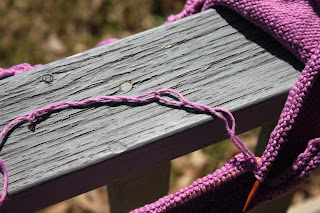The second method, duplicate stitching is probably the easiest to explain. Basically you overlap the two yarns, old and new, about 3-6 inches (depending mostly on the weight of the yarn) and knit with both yarns until the old one runs out. You may have to weave in or tighten a loose end when you're done, but it stays extremely secure and surprisingly is not bulky (most of the time). Here's a quick picture for you:
 |
| Just hold the two strands together for a length and knit with both strands as one |
The first method mentioned, the Russian join, is also one that works really well with wool I have found. You take a tail of about 6 inches of the old yarn and thread a yarn needle, fold it back on itself and weave it back into the strand to create a loop at the end. You then do the same with the new yarn, making sure that the loop interlocks with the old loop. Here's a quick picture for you of this one:
 |
| These aren't woven into the strands, merely wrapped, but you can see the loops that link |
There are several websites that explain these two methods in detail, and I may later on provide a video for you, but that's the quick and dirty explanation. The only problem I have is that I'm not working with a wool yarn. I have a linen/cotton blend. This complicates things. Linen and cotton fibers do not cling the way wool fibers do. They are much smoother since they are a plant fiber and not a protein fiber. So, I have been looking into other ways to attach the new skein. Some suggest a knot (heaven forbid! So many will tell you NEVER knot your knitting!), others suggest the Russian join or duplicate knitting methods I described above. There is also a braided join, which splits a length of each yarn (about 3-6 inches again, depending on the weight of the yarn) and braids the plies together. This I think works best for an acrylic yarn, or one that is plied and tightly spun. The braid should wind up about the same diameter as the plied yarn, and virtually undetectable when knit up.
The other issue I ran into is that most tell you to join at the end or edge of your knitting. Problem one with that: it's in the round. Problem solution: use the underarm/marked side seam of your knitting to join. Problem two: I hate wasting that yarn. Problem solution: well, unless I get over not wanting to waste the yarn, there really isn't one. I am one of these crazy insane people that wants to use every inch of yarn I have bought to really get my money's worth. Even cheap, squeaky, tacky acrylic yarn will be subject to my unnatural need to use every inch. I don't want even a single millimeter to go to waste. I keep all my ends, never throwing them away, to use as filler when doing a stuffed project. That's how far I will go. I guess it's a tribute to my grandparents, who were products of the Depression era, and never wasted a thing. My grandmother would reuse aluminum foil until it had holes in it.
Here is what I finally decided to do: I just knit with the two strands held together. I can tug at them and get it to look normal, so as I now knit it up, I won't waste any yarn and it's less time consuming than another possible option.
 |
| About 4 inches of the sweater knit and ready to join the new skein! |

No comments:
Post a Comment